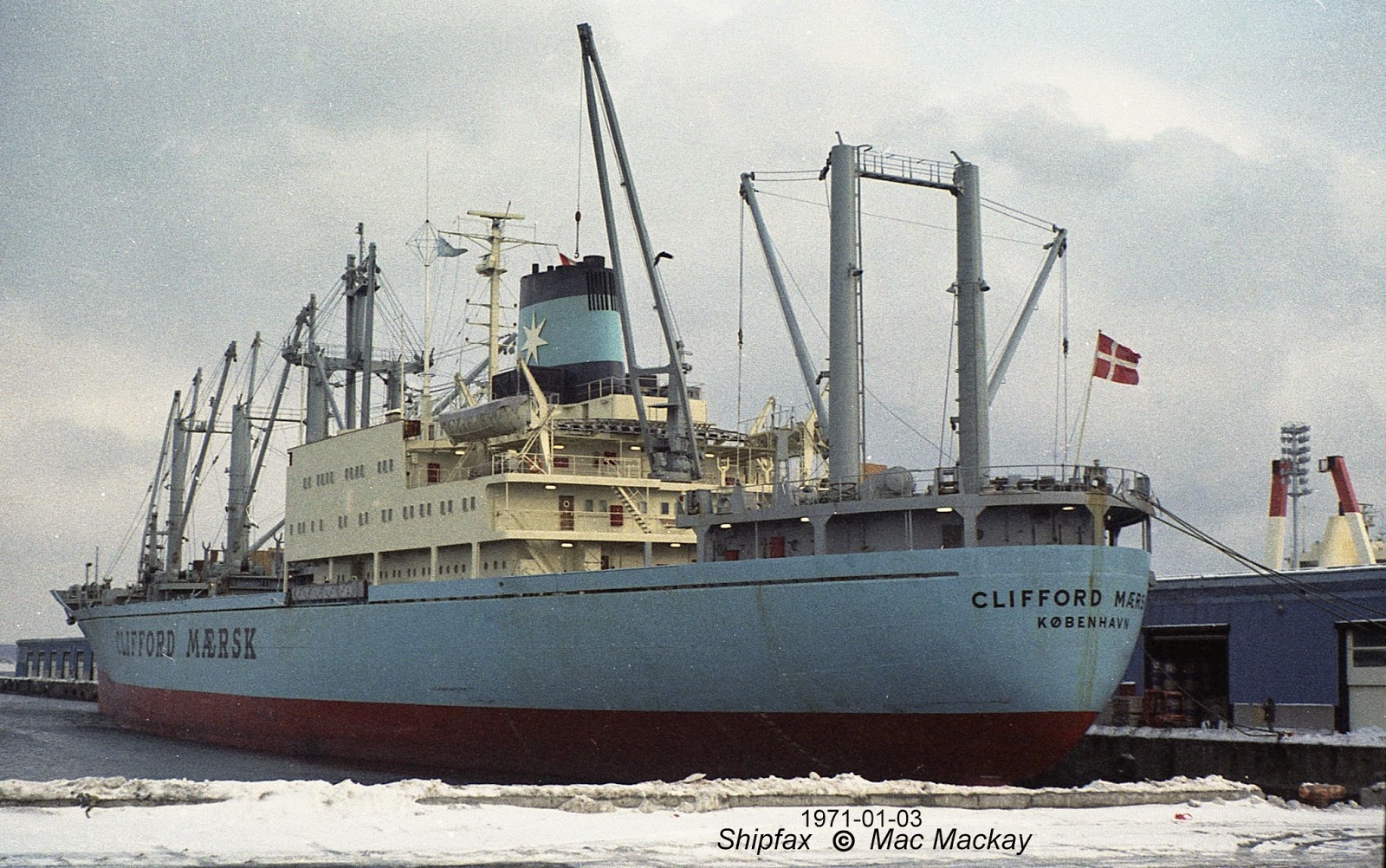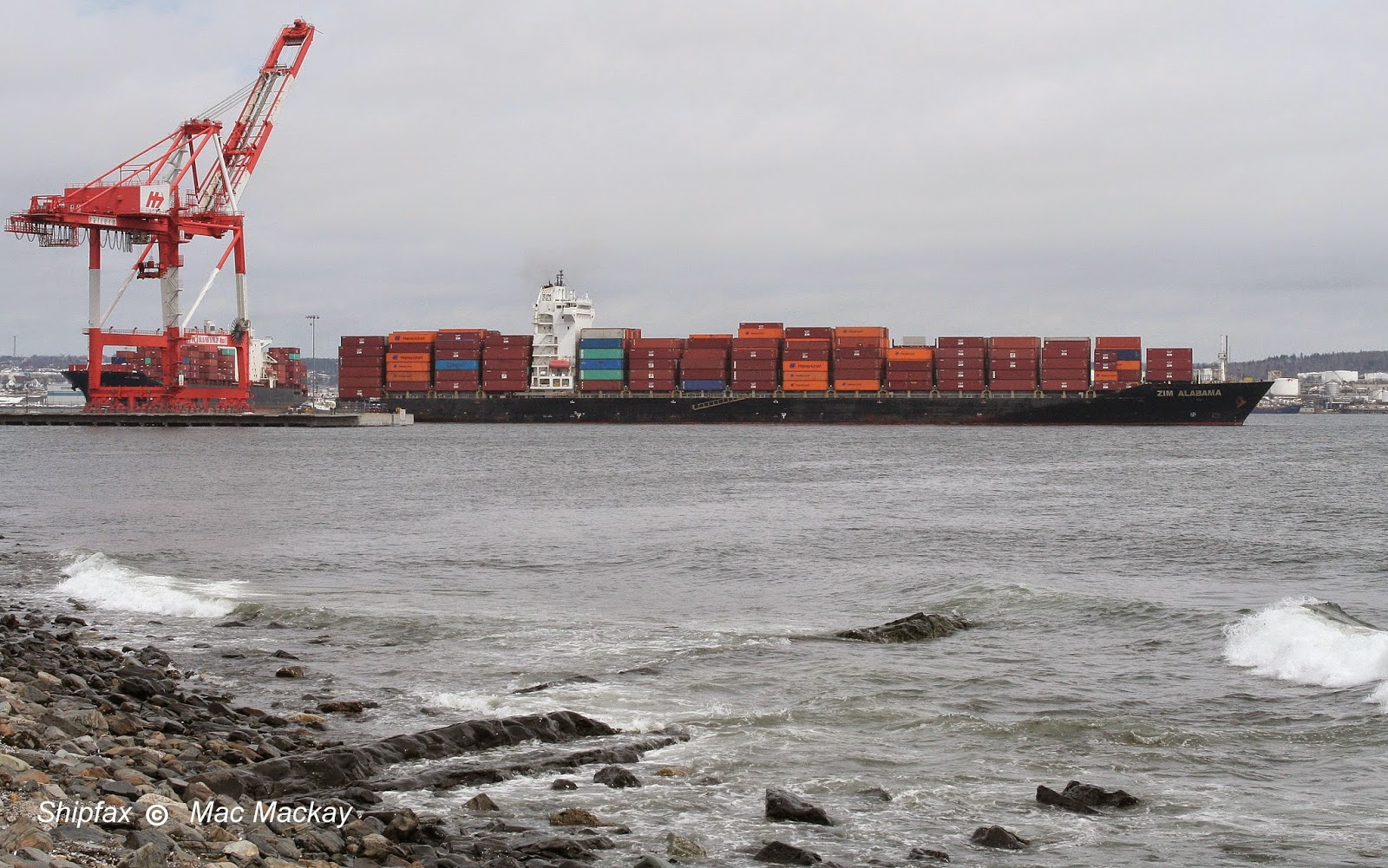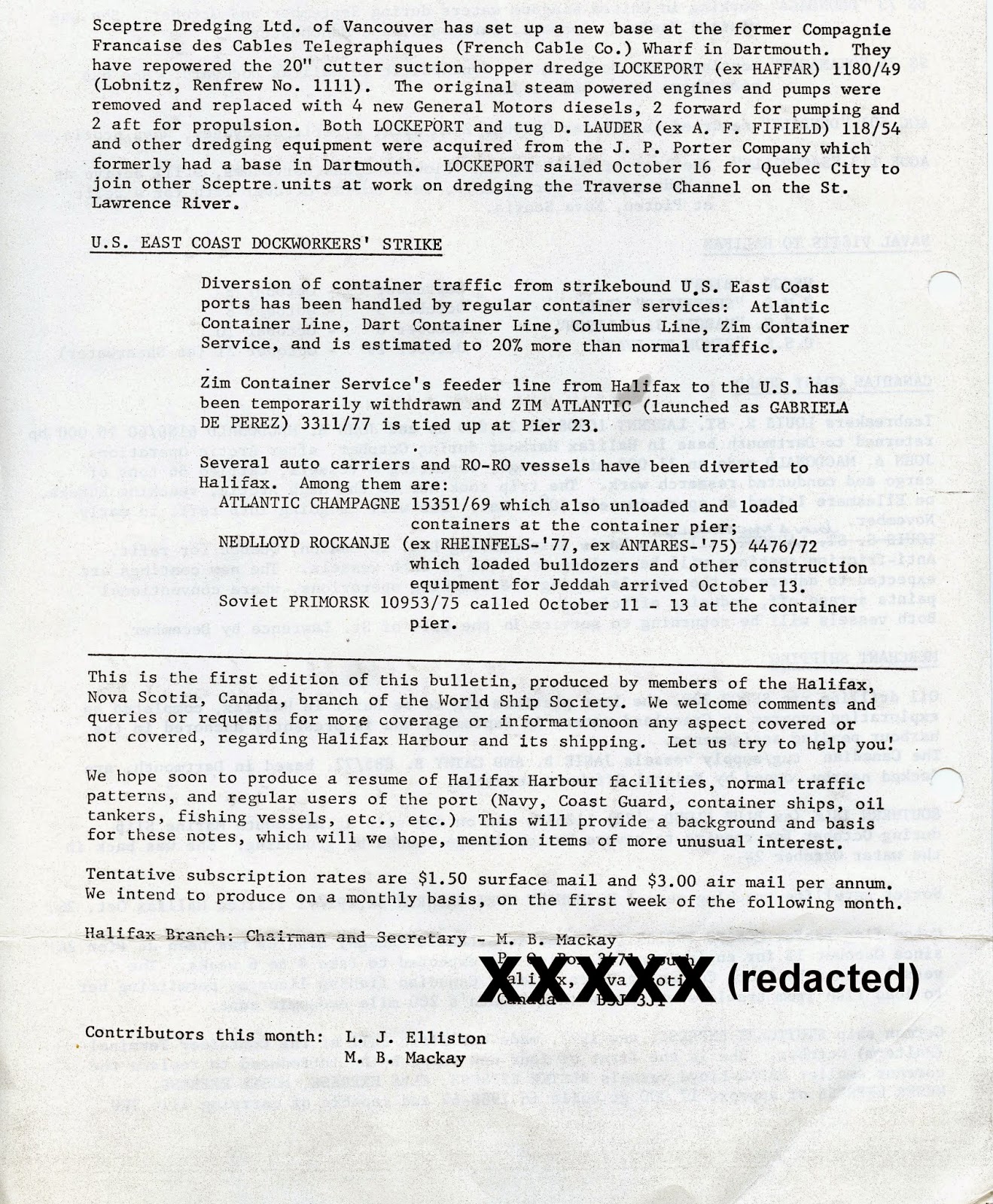An earlier post in November 2014:
Reefer Madness Then and Now noted the large amount of reefer traffic in the port of Halifax - now almost exclusively in containers. Exports are mostly sea food and potatoes (not only whole, but especially frozen french fries), with some apples and other produce. Imports include every kind of food stuff from fresh fruit to prepared foods. The export cargoes are collected from all over the Atlantic provinces, and the import cargoes are distributed even more widely, to central Canada and the mid-western United States.
In yesterday's post I covered small reefer ships, generally concerned with fish exports. Today it is the turn for big ships. Big reefers are generally handsome ships, built for speed, and usually painted white to reflect the sun and help to control the temperature in the holds.
In the pre-container era, there were four main reefer operators sen in Halifax, and several smaller ones. I have previously mentioned Maritime Fruit Carriers (MFC), the Israeli company founded in 1961 that became over extended and was forced into bankruptcy in 1975.
FYFFESThe other large carrier was Fyffes, an Irish Company primarily involved in the banana trade. Founded in the 1880s, they merged with
Elder Dempster in 1901 to form Elders + Fyffes and in 1902 a 45% interest was taken up by the United Fruit Co. In 1969 Elders+Fyffes was renamed the Fyffes Group, with its primary European terminal in Southampton.
Ships returning the Caribbean particularly, often stopped in Halifax - not with bananas, but to pick up export cargo for the Caribbean, and also corrugated cardboard and box board, which was produced in Atlantic Canada. They also operated cross trades, with Mediterranean fruit direct to Halifax.
Mare Antartico was built in 1967 by Ansaldo, Muggiano, Italy for the aptly named Cia Marittima Bananiera Italiana, part of the the Fratelli d'Amico empire [as of 2014 the world's largest operator of product tankers, they have left bananas well behind.] At 6955 grt, 5575 dwt and powered by a 10,800 bhp 9 cylinder B+W - Ansaldo main engine it cruised at 19.5 knots. Its four holds are served by eight 5 ton derricks, and there are side doors for each hold as well.
It was chartered to Ffyfes/United Brand and is wearing their colours in Halifax, likely to load paper, since it appears to be in ballast. It arrived in Brindisi December 24, 1985 to be broken up.
Manistee dated from 1972 when it was built by Kawasaki Heavy Industries in Kobe Japan. A departure from the traditional reefer, with engines and accommodations 3/4 aft, it still gave the impression of speed, and with its 12,600 bhp MAN-KHI engine it made 21.5 knots. It measured 6513 grt, 6127 dwt and cargo hatches were served by four 5 ton cranes and four 5 ton derricks. It has side doors for all holds, but they are barely visible in this photo.
Transferred to the Hong Kong flag in 1984 and renamed
Fleet Wave, it was sold in 1990 and renamed
Mimoza, under the Bahamas flag. It arrived in Alang June 30,199 for scrap.
Morant was nominally a sister ship, but built two years earlier by the same yard, and was equipped only with derricks. It took twelve 5 ton derricks to serve all the holds. The ship had four side doors on each side.One just under the flare of the bow serving number one hold, one for number two hold, barely visible, one for number three hold (just aft of the pilot ladder) and one for number four hold, just where the red boot topping begins to curve upward. There is also smaller "man sized" door below the lowest part of the superstructure.
In this photo, the ship is outbound from pier 9C and is up to harbor speed as it heads east of George's Island. It was sold to Akbar Cold Stores of Jeddah, Saudi Arabia in 1982 and renamed
Al Zohal. On January 22, 2000 it arrived in Alang, India to ber broken up.
SALÉN Sven Salén was once the largest ship owner in Sweden. Having started his first shipping company in 1915 to transport bananas, he was among the pioneers in the reefer business.
The name has almost disappeared now having merged into Lauritzen's Cool Carriers. At one time however in addition to owning a large fleet, the company also managed reefers for others, including many of the MFC ships for the receivers, and several Fyffes ships. Included in this number were the world's largest reefers, mentioned here
March 1, 2015 . Thus the distinctive blue funnel with white S could be seen on many ships, not just their own..
Altcar was built as
Arawak for Rederi "Arawak", a 50/50 joint venture between Salén Rederierna and Rederi A/B Transatlantic in 1965 by Eriksbergs MV of Gothenburg (Transatlantic and Eriksberg were owned by the Brostrom family). Measuring 8023 grt, 8230 dwt, the ship carried an 8 cylinder, 10,000 bhp B+W giving a speed of 19.5 knots. In 1970 the ship was fitted with a bulbous bow which improved its performance, and perhaps its speed. Carrying only four cranes of 5 tons, it also had side doors (one is barely visible just forward of the superstructure.
With the collapse of the Swedish shipping industry the Salén / Transatlantic partnership ended in 1978 Salén took 100% ownership of the ship, then sold it to Dearfield Co Ltd (managed by Constantinos Torridakis under the Bermuda flag) and took back a charter, renaming the ship
Altcar. It is seen here at pier 9c with cargo netting in place after longshoremen had knocked off for the day. It was loading box board.
On August 21, 1983 the ship was laid up in Brunei Bay, Borneo and arrived in Kaohsiung, Tai3wan July 4, 1984 to be broken up.
Despite a shadow from the grain leg at pier 24,
San Bruno stands out at pier 23. A sister ship to
Arawak /
Altcar, it was built in 1967 by the same yard. Its engine was slightly larger at 10,5600 bhp, thus squeezing out a speed of 20.25 knots. Built for Rederi A/B Salénia, it was transferred in 1978 to Trans Swedish Shipping Inc, under Salén management, but flying the Philippine flag. Under the same ownership it was renamed
Malayan Venture in 1983, and arrived in Shanghai in Jume 1985 to be scrapped.
RUDOLF OETKER Hamburg, Germany has long been a hub for refrigerated cargoes in northern Europe. It was there that Rudolf Oetker got his start in shipping in 1871, and created a family business empire. His eight children with three wives each owned 12.5% of what expanded into many divisions, the largest being the huge container enterprise Hamburg-Sud. Over the years it took over such other lines as Furness-Withy, Pacific Steam Navigation, some of Ellermans routes, Costa and many others. It also founded Columbus Line, a transpacific container line that used to call in Halifax, but which folded back into H-S in 2004. At first trading primarily with South America, H-S naturally gravitated toward refrigerated cargoes, and the expansion of dedicated reefers began in the early 1950s under the Rudolph Oetker name.
As a partner in the Lauritzen Cool pool, H-S eventually decided to concentrate on containers and sold its last reefer ship in 1999.
Wesermunde, here seen a pier 23, was a product of Bremer Vulkan, Vegesack in 1959.Powered by a 7 cylinder Bremer Vulkan engine of 6800bhp for a speed of 18 knots. It carried four cranes and two derricks rated at 5 tons (the derricks seem to have disappeared by the time this photo was taken), and measured 3139 grt, 3450 dwt. There is a side door placed very low in number one hold. In 1976 it was sold to Greek owners and chartered back to Oetker.
On May 6, 1982 it suffered a fire 4 miles off Aqaba on a voyage from Tampa to Aqaba with a cargo of eggs and food stuffs.
Marko Polo began life as Oetker's
Cap Domingo in 1958 at Kieler Howaldswerke. The 2879 grt, 2982 dwt ship achieved 17 3/4 knots from its 9 cylinder, 6000 bhp MAN-Kieler. It has four side doors port and starboard, serving the tween decks of each hold.
Lloyds gives the ship one 10 ton and seven 5 ton derricks.
In 1970 it was sold to Det Bergenske D/S of Norway and renamed
Crux. It carried that name until 1973 when it became
Marko Polo for Mediteranska Plovidba of Split, Yugoslavia (now Croatia). In this photo it is likely loading potatoes at pier 33.
It arrived in Split May 17, 1985 where it was subsequently broken up.
LAEISZ Also based in Hamburg, the "Flying P" line of square riggers (all had names beginning with the letter P), known for their great speed in running round Cape Horn
in the nitrate trade, made the name of Ferdinand Laeisz almost a household word. Herr Laiesz was a hat maker with world wide interests, including import and export, but it was his son Carl who really got the shipping company going in 1857. Following World War I, the firm moved into refrigerated shipping, and again after World War II, having lost all its ships. Since then they have expanded into banking, insurance and real estate, but still operate a variety of shipping. Before taking delivery of the first full container reefer in 1983 they operated dedicated reefers, but have now become shareholders in the United Fruit Company and also operate autocarriers.
The impressive
Persimmon was built in 1975 by Deutsche Werft, Finkenwarder and measured 6501 grt, 6560 dwt. It was powered by a 9 cylinder, 11,400 bhp MAN giving 22 knots. With conventional cargo derricks, one 3 to 8 tons and seven 3 to 5 tons, it only served Laeisz for four years when it went to Paton Shipping Corp of Panama and was renamed
Grand United, with a charter back.
Appearing sadly neglected only two years later,
Grand United loads potatoes at pier 33. Note the tarps slung from the derricks to protect the cargo from rain. When Laiesz had to reorganize in 1982, and the charter was not renewed, the ship was sold to another Panamanian owner in 1983 but was sent to the scrappers in Lisbon, arriving Mar 13, 1985. That such a ship should on ly last ten years shows how the reefer container revoluitionized shipping almost over night.
MiscellaneousThere were many others in the reefer business, but it must have been highly volatile since the ships changed hands a bewildering number of times. Two typical examples:
Maraki, seen here leaving the Welland Canal, in Port Colborne, ON, was not only in a strange place for a reefer, it was also on its eighth and final name in 1983.
Built in 1963 by Empresa Nacional Elcano in Seville, Spain, it was a ship of 6420 grt, 5521 dwt, with a 6 cyl Sulzer-Elcano giving 18 knots. It carried eight 5 ton derricks on stylish bipod masts.
First named
Northpole under the Greek flag for Liberian Refrigerated Carriers Corp it was renamed
Atlantic Arrow for a time during 1966, before it was sold in 1976 to El Yam Bulk Carriers of Israel when it became
Har Bashan. They sold it to Côte d'Ivoire in 1973 as
Assouba, and then it was sold on in 1980 as
Flamingo, then
Famingo II in 1982 and finally
Maraki in 1983 for a variety of Panamanian owners.
It arrived in Gadani Beach, Pakistan March 25, 1985 where it was broken up.
Macfrost was halfway through its eight names when it called in Halifax to load potatoes in 1987. (There was ice in the ports in Prince Edward Island, which most reefers chose to avoid.) Atelier et Chantier de Dunkerque et Bourdeaux built the 8559 grt, 6595 dwt ship in 1969. It was powered by a 13,860 bhp B+W - Creusot and made a speed of 15 1/2 knots. It was fitted with four 5 tons cranes only and had numerous high and low side doors - several of which can be picked out by rust streaks.
Soc. Courtage et Transport of Dunkirk named the ship
Marsouin , transferring it to Cie de Nav Frutière in 1979. In 1980 it began its journey through various flags as
Juniper (Liberia), 84:
Arietta, 85:
Macfrost both for Armadora Cia Frigo Linea SA.
Then in 1987 as the Greek
Chios Dignity, 90:
Miami Reefer, Malta 92:
Bluemenau Reefer, Cambodia 97:
San Nicolas.
Remarkably it lasted to June 2003 when it was broken up in Alang.
And FINALLYNo account of reefers would be complete (in my mind) without mention again of my favorites, the
Polars.
Built for Hamburg-Sudamerikanische D.G. by Blohm + Voss in Hamburg, they were not only remarkable looking ships, they were among the most modern of their time featuring many innovations. The unfortunate choice of Pielstick engines apparently resulted in major headaches including a propensity for crank explosions. Those 14,880 bhp engines drove the ships at an impressive 23 knots (20.5 knots was quoted by less impressed sources). Tonnages have been variously reported, but grt was about 5500 to 5600.
Built in 1967-68, they were all sold off in 1976-78. Only two made an appearance in Halifax that I can recall.
Polar Paraguay was not renamed when sold to Liberian owners in 1977, then to Panama flag owners a few years later. It spent many months at pier 9A after it was arrested in an action by the National Bank of Greece after it broke charter. The crew eventually abandoned the ship and it was sold by the Federal Court at auction in December 10, 1985. The new owners renamed it
Frio Mexico under the Cyprus flag and it went to the breakers in Alang February 11, 1993.
I try not to publish the same photo twice, so this is from a slightly different angle than the previous one:
Polar Ecuador storms out of Halifax, and appears to be racing past Ives Knoll after leaving Eastern Passage. It had arrived Jul 4, 1979 and docked at Autoport. Perhaps it was carrying some special automobiles, but it was certainly not a regular autocarrier here.
In October of the same year, it collided with the 333 grt coaster
Pelikan in Kiel Bay. The coaster did not stand a chance and was so badly damaged it was sold for scrap.Damage to
Polar Ecuador was reported as minimal.
It also was not renamed after it was sold to Liberian owners in 1976, but did take the name
Chios Spirit in 1982. It arrived for demolition at Gadani Beach July 31, 1985.
More reefers to come? - stay tuned............











































































































